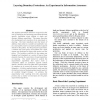Free Online Productivity Tools
i2Speak
i2Symbol
i2OCR
iTex2Img
iWeb2Print
iWeb2Shot
i2Type
iPdf2Split
iPdf2Merge
i2Bopomofo
i2Arabic
i2Style
i2Image
i2PDF
iLatex2Rtf
Sci2ools
ACSAC
2000
IEEE
2000
IEEE
Layering Boundary Protections: An Experiment in Information Assurance
The DARPA Information Assurance Program has the aim of developing and executing experiments that test specific hypotheses about defense in depth and dynamic defense capabilities. This paper describes the development and execution of an experiment in layering. The basic hypothesis was that layers of defense, when added in a careful and systematic way to a base system, lead to increased protection against attacks on the system. For the particular experiment, a mission and broad policy were defined and a base system was developed to support the mission and the policy. The boundary controller for the system was designed and developed as a series of layers; these elements became the main focus of experimentation on layering. The results tended to confirm the experimental hypothesis that layers have a cumulative effect on protection against outside attacks. However, there are often other opportunities for attackers to go around the layers or avoid them altogether. A broader methodological r...
ACSAC 2000 | Basic Hypothesis | DARPA Information Assurance | Dynamic Defense Capabilities | Security Privacy |
| Added | 30 Jul 2010 |
| Updated | 30 Jul 2010 |
| Type | Conference |
| Year | 2000 |
| Where | ACSAC |
| Authors | D. Johnson, L. Benzinger |
Comments (0)

